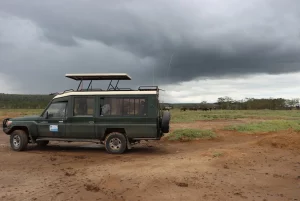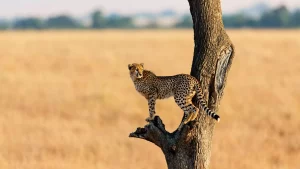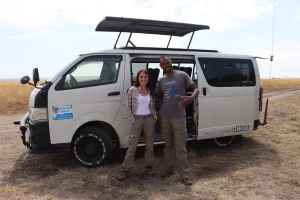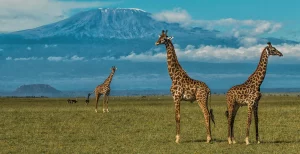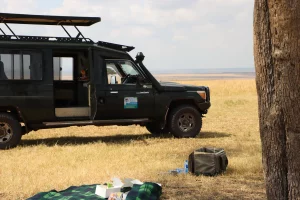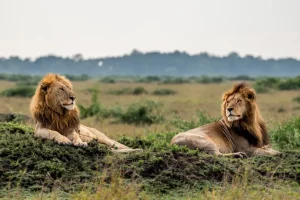Great Migration Masai Mara | 4 Days Masai Mara Wildebeest Migration Package - 2024

Our 4 Days, 3 Nights, Masai Mara wildebeest migration package introduces you to the 8th wonder of the world. The event also called the great migration Masai Mara or the Great wildebeest migration in the Masai Mara, occurs every year from July to October.
The wildebeest migration in Masai Mara is so bewildering that in 2007, it clinched a spot on the list of ‘8 wonders of the World’. It is also celebrated as the largest overland migration on earth.
Contrary to popular belief, there are no fixed Masai Mara migration dates since it is not a single crossing occurrence but a circular and endless event. The over 1.8m wildebeest, zebras, and antelopes constantly move across the Serengeti National Park and the Masai Mara National Reserve.
In total, the herds cover a distance of over 3000 kilometers annually. The crossing of the Mara River (between July & August) is just one part of the circular movement of the migrating flock.
After the river crossings, the herd stays in Mara National Reserve till early October. They then cross over to the north of the Serengeti and continue with the circular movement, only to do the Mara river crossings again the following year.
The drama that ensues during the event, especially at the crossing of the Mara River, is indescribable. And you can experience all that and more when you book our wildebeest migration safari packages. If you are wondering how to be part of the migration in the Serengeti and the Mara, here are our contact details.
How to Book Our 4 Days Masai Mara Wildebeest Migration Package
The package is loaded with fun and adventure of the Mara River crossing. However, if you wish to customize it in any way, maybe to add more destinations, just call or WhatsApp us at +254-748-258-880.
Masaimarasafari.in is a fully owned subsidiary of the Nairobi-based Ajkenyasafaris.com ltd. So you can also contact us through safarioffers@ajkenyasafaris.com or reach me directly at james@ajkenyasafaris.com.
We will happily tailor-make the perfect wildebeest, zebra, and antelope migration for you.
The Summarized, 4 Days, 3 Nights Migration Safari Itinerary
| Safari Details | Highlights |
|---|---|
| Day 1 | Pickup from JKIA, Transfer to Mara, & Afternoon Game Drive Overnight at Various Camps/Lodges |
| Day 2 & 3 | Full-Day Game Drive at Masai Mara with Packed Lunch Overnight at Various Camps/Lodges |
| Day 4 | Morning Game Drive, Maasai Village, & Transfer to Nairobi |
| Items Included | 4×4 Safari Land Cruiser, Park Fees, Game Drives, Bottled Mineral Drinking Water, Service of a Professional Guide, Full-Board Accommodation, Pickups, Transfers, and More |
| Items Excluded | Visas, Hot Air Balloon, Money Transfer Fee, Laundry Service, Flight, and Tips & Gratuities |
| Safari Price | From USD 2305 Per Person Sharing Based on 2 Pax |
The Detailed, 4 Days, 3 Nights Wildebeest Migration Safari
Without further ado, here are the summarized, Best Masai Mara Safari Packages day-by-day activities.
Day 1: Pickup from JKIA, Transfer to Masai Mara, & Afternoon Game Drive
Your dedicated safari guide will be at the airport an hour before your designated arrival time to welcome you to Kenya formally. You can travel to Mara by road or by flight.
If you choose a flight, then the guide will transfer you to Wilson airport to catch a forty-five-minute flight to Mara. Rest assured, the vistas from up there are as captivating as they are overland.
However, this safari is based on road transfer in a safari land cruiser. Traveling by road, you will start your Kenya safari by boarding our comfortable safari vehicle and traveling via the tarmacked Ngiro-are road.
Approximately 45 minutes into the trip, you will get to the Rift Valley Viewpoint, where you will have a chance to experience this majestic view. The Rift Valley is a long continuous geographic trench that runs from Lebanon to Mozambique.
It contains a series of lakes and escarpments, some of which can be seen from this viewpoint. It will also be an opportunity to take amazing pictures with the Great Rift Valley as your backdrop.
You will then resume your journey and travel for another 3 hours to Narok town. Here, you will stop over for any last-minute shopping you may wish to do as the next stop will be in the mara. From there, the guide will drop you at the camp/lodge and leave you to take lunch before you start the migration tour.
After some brief rest, you will go for an afternoon game drive which will commence at 3 pm. Here, you will experience the wildebeest migration firsthand aboard an overland 4×4 cruiser.
The animals you will likely encounter are giraffes, buffalo, elephants, hippos, zebra, wildebeests, and the king of the jungle.
Day 2: Full-Day Game Drive at Masai Mara National Reserve with Packed Lunch
Sunset accentuates the Mara in ways you can only experience through game drives. On day two of your packages, yours is to thrive in this magnificence. Only gently disrupting the peaceful morning quiet with the vrooms of our 4×4 top-off Land Cruisers, which offer optimal game viewing.
The Mara cats are vicious then; the easiest to spot are the lions, the cheetahs, the big 5, and the over 99 mammal and reptile species in the Mara.
You span far and wide into the plain grassland, heading east to the sandy thickets of Ngama Hills for the black rhinos. You also head west for the grass and acacia woodlands of the Mara.
The heart of the Mara presents an ironic twist. Despite being the most densely populated part of the park, it records the least number of visitors.
The view from here is brilliant, the cherry on top being the Mara River which is the biggest barrier during the migration. This part of the Mara is unspoiled, serene, and undoubtedly the best part of our Masai Mara migration safari trip .
Your packed lunch shall be by the breathtaking grasslands and acacia woodlands characteristic of the Central Plains. The afternoon game drive shall take you west, across Mara’s Central plains.
Herbivores such as zebras, elands, giraffes, topi, wildebeests, impalas, gazelles, and warthogs are among the animals you can expect to see. The migration is the only remaining multi-species migration worldwide.

Day 3: Full-Day Game Drive at Masai Mara with Packed Lunch
In the Mara; two similar Mara game drives are a myth, which is why you go for yet another game drive on day 3 of this Kenya Migration safari package. The goal is to look for animals you might have missed on your previous game drives.
Photographers are allowed one-on-one with the wildlife, while the birders are taken to spots where the birds are in their highest numbers. Your game drives end at dusk, but not before an optional bush dinner complemented with a glass of wine.
The migration is one of the most booked safaris in Kenya, and in the past two days, you might have seen thousands of wildebeest, zebra, and antelopes. Don’t worry that the full-day tours are over since you will see the wildebeest on the 4th day before heading out of the reserve.
Day 4: Morning Game Drive, Maasai Village Visit, & Transfer to Nairobi
As your Mara escapades draw close, you will have an early breakfast and then check out with your bag. You wrap up the Masai Mara packages nicely with one last morning game drive in a land cruiser.
It might be the last day of the migration safari but the wildebeest and other herds will be in plenty. After which you head to a Maasai village at around 10 am.
Are you in the mood for a bit of chit-chat and culture? A Maasai village visit is a chance to experience the Maasai people’s rich cultural heritage. The Maasai are one of the few African communities that have fully managed to conserve their incredible cultural heritage.
The Mara gets its name from the Maasai people, a community popular for its surprising coexistence with the wild. Beads, Mara paintings, and pottery are excellent accessories that the community sells. Do get involved in some Maasai cultural dances before heading back home.
After the Maasai village tour, depending on your travel arrangements, you will head back to Nairobi for your international flight. Lunch is on the way, at Narok town as you will arrive in the evening, and the drop off is at the airport or Nairobi hotel.
Items Included in the 4 Days Masai Mara Wildebeest Migration Package
- Airport pick-ups and return at the end of the trip
- A private, well-versed tour guide, Kenyan and multilingual (Gold or Silver level)
- Round-trip transport to all attractions and destinations
- Afternoon Game drive on day 1
- Full-day game drive on days 2 and 3 with packed lunch
- Morning game drive on day 4 when staying inside the reserve
- Maasai village visit on day 4
- Lunch at Narok town on day 4
- Full-board accommodation during the safari
- Masai Mara games reserve entrance fees
- Bottled drinking water in the safari vehicle
- All applicable taxes during your stay in Masai Mara
Items Excluded from the 4 Days Migration Safari Price
- Hot Air Balloon Safari at USD 475 per person
- Travel Insurance
- Tips and gratuities
- Visas
- Laundry Service
- Money Transfer Fee
Safari Price Per Person Sharing for 4 Days Migration Safari – Based on 2 Pax for 2024
| Masai Mara Camp/Lodge | Road-Trip Price Per Person Sharing | Fly-In Price Per Person Sharing |
|---|---|---|
| Basecamp Adventure | USD 2305 | USD 2825 |
| Sentrim Masai Mara | USD 2320 | USD 2840 |
| Enkorok Camp | USD 2373 | USD 2893 |
| Drunken Elephant Camp | USD 2425 | USD 2945 |
| Masai Mara Sopa Lodge | USD 2490 | USD 3010 |
| Mtito Safari Camp | USD 2545 | USD 3065 |
| Basecamp Masai Mara | USD 2575 | USD 3095 |
| Malaika Camp | USD 2635 | USD 3155 |
| Keekorok Lodge | USD 2734 | USD 3254 |
| Mara Serena Safari Lodge | USD 2860 | USD 3380 |
| Tipilikwani Mara Camp | USD 2905 | USD 3425 |
| Ashnil Mara | USD 2911 | USD 3431 |
| Mara Crossing Camp | USD 2965 | USD 3485 |
| Sarova Mara Game Lodge | USD 3010 | USD 3530 |
| Mara Maisha Camp | USD 3110 | USD 3630 |
| Ilkeliani Mara Camp | USD 3325 | USD 3845 |
| Entim Mara Camp | USD 3670 | USD 4190 |
| Mara Intrepids Camp | USD 3907 | USD 4427 |
| Heritage Mara Explore | USD 4207 | USD 4727 |
Masai Mara Migration Safari Travel Guide – FAQs
Our cheap Masai Mara safari packages for migration season are guaranteed to provide you with value for your money. With that said, here are some things you might want to know about one of the most spectacular events on the earth.
1. How can I see the great migration in Africa?
Once you land in Nairobi, there are two ways to get to Mara- by flying to Masai Mara or by road. We offer you customized Masai Mara safaris and help you experience the migration in the best way possible.
Flying is the faster means to get there, but we recommend taking one of our road trips to the Mara for a more adventurous time. Here, we shall introduce you to bonus features that our lovely country has in store, such as the attractions along the picturesque Great Rift Valley.
2. What month is the Great Migration in Kenya?
The Migration Masai Mara best time for all travelers is between July to October. That is when the wildebeest and other herds move from the Serengeti Plains in Tanzania to the Masai Mara National Reserve in Kenya in search of pasture.
Since the animals move in cyclical patterns, you are assured of catching repeated action during these periods. In Kenya, we have great weather all year round, so viewing the wildebeest during these months is a rewarding experience.
3. What is the best time of year to visit Kenya?
In Kenya, we enjoy excellent weather all year round. Nonetheless, some months are drier than others. Typically, July- September constitutes the country’s dry season and the best time to come for the wildebeest movement, while the short rains are experienced from October to December.
Therefore, if you wish for the best Masai Mara migration safari experience, you should schedule your safari within the dry months. The great migration is also starting by the end of June. There is very little rainfall between June and October and if maximizing Kenya’s fantastic weather is your goal, then this is the time to visit. Conversely, the height of the wet season happens between March into the early April. This is when the prices are at the lowest as the number of travelers is also low.
4. How do wildebeest know where to migrate?
Experts say the herds can sense the heightened presence of phosphorus and nitrogen in the air and, by extension, greener pastures and water ahead. Others say it is just a matter of simply inexplicable instinct as they follow the rains.
It is baffling how a herd of more than 2 million animals can be so synchronized and move in an organized fashion despite the perils ahead. Hundreds of wildebeest perish during the river crossing as they drown or fall prey to crocodiles.
5. Where is the best place to see the great Migration?
The Masai Mara is the best place to witness the herds movement in Africa. Why? The reserve is one of the only two destinations where migratory herds are found.
The only other destination is the Serengeti Plains in Tanzania (within the Serengeti National Park). However, compared to the Serengeti National Park, which sits on a massive 14,750 Km2, the Mara Game Reserve only covers a mere 1,510 km2.
The smaller size of the Mara Game Reserve affords you a far greater chance of spotting an enormous number of animals than the Serengeti. Besides, the river Mara crossing is found in the Masai Mara, and here we will show you the action.
6. How far do wildebeest travel during migration?
During the year, the herds and other wildlife are always on the move and travel over 3,000 km. They move from the Serengeti Plains in Tanzania to the Mara Game Reserve in Kenya in search of food and water.
They move in a clockwise fashion across the Serengeti following the rains. The timing of the Great Migration in Africa also depends on nature; for the animals, it is all about obeying their instincts.
The 3,000 km odyssey is fraught with dangers from predators, but notwithstanding, the animals still undertake the daunting journey to get the best of food and water.
7. How much does a Masai Mara safari cost?
Our packages of the migration season start from as low as USD 250 Per Day to over USD 1000 for luxury tours. This is to ensure that there is no one left behind who would wish to visit the reserve during this time of the year.
The most attractive bit is that we tailor the wildebeest packages to suit your logistical preferences. Also, these budget-friendly and luxury excursions are conducted by seasoned guides, making them one of the most rewarding tours in Kenya.
Our guides show you the action and share in-depth knowledge about what you are witnessing and when to expect the Mara river crossings. Also, regardless of your package, we always ensure you get the best services, no matter the package class as the migration is for every traveler to enjoy.

8. How many days do you need in Masai Mara?
You can never have too much time in the reserve. At the very least, you should spend four days and three nights. If you plan a Kenya package, up to 5 days are ideal no matter the month of the year you come. This can be ideal as it increases your chances of spotting all the herds in the reserve.
This is the minimum duration within which you can get an overview of the Reserve, particularly during the Great animals’ migration in Africa.
9. Is Masai Mara Safari safe?
The reserve is a very safe destination to travel to any day of the year. Our locals, mainly the Maasai, are one of Africa’s most friendly and culturally rich indigenous communities.
Not only have they managed to co-exist with wild animals for decades, but they are also very welcoming of visitors every day of the year.
10. What month is the great migration in Tanzania?
Between November and December, the herds return to Serengeti, Tanzania, having spent the time between July- October in Kenya. Once back in the Serengeti, they stay there until the next dramatic annual migration the following year.
You may visit the herds in Kenya or Tanzania. But if drama and excitement are what you crave, the best time to visit would be in July to August in Kenya. That is when the Mara River crossing happens in all its splendor.
11. Why do wildebeest and zebras travel together?
Various factors inform why zebras and wildebeests do the Mara river crossing. For starters, there is strength in numbers, and large herds have a higher chance of survival against predators.
Secondly, there is an element of symbiosis between the two species. While wildebeest have an excellent sense of smell, zebras have better vision than wildebeests.
Together, they present formidable allies against predators.
Another way they complement each other is their eating habits- while zebras eat the taller blades of grass, wildebeest prefer the shorter, tender grass. This means there is no competition for food, as everyone sticks to their lane!
12. Kenya Migration Safari – Masai Mara Serengeti Migration Facts:
Over 1.5 million wildebeest and 200,000 zebras, and hundreds of thousands of other herbivores participate in the hazardous safari. The annual migration is the 8th wonder of the modern world.
The only reason the wildebeest and other herbivores engage in this life-threatening excursion is to secure greener pastures after exhausting the south of the Serengeti. Kenya’s migration occurs between July and October, which is just after the rainy season.
The annual animal migration is the largest overland animal movement and the best time to see the river crossings is between July and August.
13. How can I go to the Masai Mara from India?
There are several ways to go to Kenya from India. You can opt for a direct flight to Kenya via major airports such as Jomo Kenyatta International Airport, Nairobi. From here, we can transfer you to the reserve using a safari land cruiser or you take a 45 flight to the park.
14. Has the migration started in Masai Mara?
Yes, the event has started in Masai Mara! Large herds of wildebeests and zebras have made their way to the reserve and are already crossing the Mara River in their quest for fresh grass. The best perfect to visit is between July and August when you can witness the annual river crossings in all their splendor.

